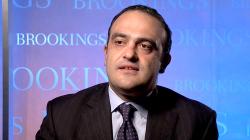INTRODUCTION
What started in the fall of 2009 as a fiscal crisis in a smaller European economy—Greece, which accounts for just 2 percent of the total euro area’s GDP—has evolved into a systemic crisis of the eurozone. This crisis now threatens not only to cause a meltdown of the entire European economy but also to destroy the social and political fabric that several generations of European leaders have worked to create over the last few decades.
While national governments are primarily responsible for the unfolding of the current events in Europe, the incomplete architecture of the euro area has created unprecedented scope for contagion by exposing each member of the monetary union—albeit to varying degrees—to the vulnerabilities of other members.
Italy is a case in point. The sluggish growth of its economy and its high (and increasing) stock of public debt are not new phenomena, but the crisis of the peripheral economies has provided the trigger for market investors to focus on Italy’s long run ability to service an increasing debt pile.
Escalating market pressure has led to the formation of an emergency cabinet led by economist Mario Monti, charged with the task of pursuing an ambitious reformist agenda. Meanwhile, the euro1.9 trillion of Italian public debt—equivalent to 120 percent of its GDP—serves as a harsh reminder to the finance ministries in Europe and abroad of the unpredictable consequences a potential fallout of a country like Italy could have on the global economy.
Given the sheer size of Italy’s debt, existing instruments—such as financial assistance programs via the European Financial Stability Fund (the European rescue fund) and the IMF—are inadequate as a financial backstop due to the limited lending capacity of both institutions. Acknowledging this limitation, EU leaders committed to “consider…the provision of additional resources for the IMF of up to EUR200 billion (USD 270 billion)” with the idea that the international community could provide matching funds “to ensure that the IMF has adequate resources to deal with the crisis.”
Meanwhile the European Central Bank has tried to address the crisis through a number of unconventional instruments, although it has fallen short of serving as a proper lender of last resort—a role outside of its mandate. At the end of June 2011, the ECB extended the liquidity swap arrangement with the U.S. Federal Reserve to provide U.S. dollar liquidity to euro area banks unable to access the interbank dollar market. In October, the ECB announced that by year-end it would conduct two supplementary 12-month refinancing operations to keep liquidity abundant for a longer period, which were supplemented in December by the unprecedented introduction of three-year liquidity refinancing operations.
Following escalating market pressures in Italy and Spain over the summer, the Eurosystem reactivated the Securities Markets Programme in August by intervening for euro206.9 billion (as of the week ending December 2, 2011). Unofficial reports from trading desks suggest that approximately 65 percent has been spent to buy Italian government bonds, 30 percent to buy Spanish bonds, and the remaining 5 percent for Irish and Portuguese bonds. While the ECB has not disclosed for how long it intends to continue the program, it is reasonable to assume that it may plan to do so until adequate safety nets are put in place.
Following the December 9th EU Summit, the strategy that the European leaders are using to stabilize the euro crisis can be articulated at three different layers: the first one is provided by the corrective measures to be enacted by euro-area national governments in the context of sharpened EU surveillance and disciplining sanctions; the second layer, or line of defense, is offered by a potential financial firewall that a stepped-up IMF can erect around the vulnerable sovereigns of the euro area, such as Italy and Spain, through lending programs with conditionality; and the third and last line of defense would be the ECB itself which would take the burden of any residual systemic pressures that the two previous layers would be unable to stabilize.
In light of these considerations, the aim of this paper is to review policy options that the international community could implement by strengthening the second line of defense, which hinges on an enhanced role for the IMF. These options all presuppose that the euro area as a whole will develop a credible and comprehensive strategy to effectively address the systemic crisis. However, given the credibility gap of European leaders in effectively resolving the current crisis, a quasi lender of last resort and a seal of approval by the international community would still be needed to stabilize markets and contain lingering uncertainty—even after a credible plan is eventually finalized. Following that, the options presented—admittedly, some highly unconventional and require further technical and legal appraisal—could be leveraged to prevent contagion to the rest of the global economy and the international financial system.
This paper also aims to more broadly explore the role of the IMF in systemic financial crises in general by underscoring the need to better align the institution’s policy toolkit in the context of a truly global monetary and financial system. In this respect, the IMF’s current financial capacity offers an inadequate backstop against a systemic event that would prompt larger sovereigns such as Italy to request an IMF rescue package.
As of December 1, 2011, the IMF’s forward commitment capacity stood at SDR 251 billion—approximately $390 billion or euro290 billion. However, in 2012 alone, Italy’s Treasury will need to rollover approximately euro286 billion worth of debt set to expire throughout the year. It is clear that under current conditions the IMF does not have adequate financial resources to address the euro crisis head-on. Below we explore the institutional feasibility of various options that could be explored to enhance the IMF’s financial firepower while taking into consideration the accompanying risks and institutional constraints for the fund and its members.
This paper is part of a series of in-depth policy papers, Shaping the Emerging Global Order, in collaboration with ForeignPolicy.com. Visit ForeignPolicy.com’s Deep Dive section for discussion on this paper.




